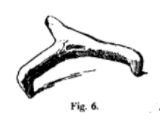


Stilts are small supports used when firing glazed ceramics to stop the melting glaze from fusing them to each other or the kiln.[1][2][3] Stilts are a form of kiln furniture.[4] Their presence in archaeological sites, where they may be known as pernette, along with other kiln furniture such as saggars and kiln bars can be used to support a case for local production.[4] Some potters avoid the need for stilts by not glazing the bottom of their products.[5] This is known as dry footing.[5]
History
Various types of stilts have been developed over the centuries:
Tripod stilt
The tripod stilt, which has three legs with a raised point on each end, appears to have been developed in China at least as far back as the third century AD.[2][6] Tripod stilts have been found during excavations in Ur.[7]
It was adopted by the Islamic world in the 9th century AD and was later adopted by the Byzantines around the start of the 13th century.[2] The use of this stilt can be deduced from damage to the glaze where the three raised points were in direct contact with it.[2] A similar type of stilt appears to have been used in the Staffordshire area and perhaps Scotland between the 1760s and 1850s.[8]
Ring stilt

Ring stilts, which consist of a ring with three raised points of clay placed at equal distances around the rim, were in use in the second half of the 18th century.[8]
Crown stilt
Crown stilts were in use during much the same time period as ring stilts.[8]
Other types

A stilt has been found at a Roman kiln site near Holt, Wrexham County Borough dating to around the first or second century AD.[9] It was designed to be used within a saggar and has clay pads supporting it within the saggar.[9]
Archaeology
In archaeology, they may be upside-down baked clay tripods, leaving characteristic marks at the bottoms of the pottery/porcelain.[10][11] They expose the bottom of the fired piece to the full heat[12] and prevent the pieces from sticking to each other.
Manufacture
In the 19th century centralised industrial production of molded three-arm stilts began common in the UK with Staffordshire exporting them to other parts of the country.[13] Some of the manufactures appear to have used distinctive mold designs.[13]
Stilts are still used and produced today and are marketed by pottery suppliers.[7]
Non-pottery uses
Some researchers have used kiln stilts as a settlement substrate for coral larva including those of the species Dendrogyra cylindrus.[14]
References
- ^ Elliott, Gordon (2006). Aspects of Ceramic History: A Series of Papers Focusing on the Ceramic Artifact As Evidence of Cultural and Technical Developments. Gordon Elliott. p. 73. ISBN 0955769019.
- ^ a b c d Papanicola-Bakirtzē, Dēmētra; Maguire, Eunice Dauterman; Maguire, Henry (1992). Ceramic Art from Byzantine Serres. University of Illinois Press. pp. 25–27. ISBN 0252063031.
- ^ Journal of the American Research Center in Egypt. American Research Center in Egypt. 1965.
- ^ a b Hunt, Alice M W (2017). The Oxford Handbook of Archaeological Ceramic Analysis. Oxford University Press. p. 151. ISBN 978-0199681532.
- ^ a b Pat, Spark; Coreson, Linda; Houglum, Lyla (2006). 4-H cast ceramics. Oregon State University. Extension Service. p. 8.
- ^ Stern, Edna J (1998). "Evidence of Early Islamic Pottery Production in Acre". 'Atiqot / עתיקות. 36: 23–25.
- ^ a b de Alarcon, Tessa (3 July 2014). "Standing on Stilts the Glazed Ceramics from Ur". Penn Museum Blog. University of Pennsylvania Museum of Archaeology and Anthropology. Retrieved 12 April 2018.
- ^ a b c Haggarty, George Raymond. "Newbigging Pottery, Musselburgh:Ceramic Resource Disk" (PDF). National Museums Scotland Research Repository. National Museums Scotland. Retrieved 7 April 2018.
- ^ a b Peel, R.A (April 1965). "Ceramics: Pottery" (PDF). The crafts of Roman Britain (MA). Durham University. pp. 42–44. Retrieved 8 April 2018.
- ^ Archæological Researches in Palestine During the Years 1873-1874. Committee of the Palestine exploration fund. 1899.
- ^ Marks and Monograms on Pottery and Porcelain: With Historical Notices of Each Manufactory Preceded by an Introductory Essay on the Vasa Fictilia of England, and Followed by a Copious Index. J. Davy. 1866.
- ^ "PERNETTE English Definition and Meaning | Lexico.com". Lexico Dictionaries | English. Archived from the original on February 21, 2022.
- ^ a b Haggarty, George Raymond. "The Verreville Pottery Glasgow "CD Rom"" (PDF). National Museums Scotland Research Repository. National Museums Scotland. Retrieved 8 April 2018.
- ^ Marhaver, Kristen L; Vermeij, Mark JA; Medina, Mónica M (16 March 2015). "Reproductive natural history and successful juvenile propagation of the threatened Caribbean Pillar Coral Dendrogyra cylindrus". BMC Ecology. 15 (9): 9. doi:10.1186/s12898-015-0039-7. PMC 4361213. PMID 25887933.

